
Basho Valley Skardu – Best Travel Guide 2025
Basho Valley Skardu, locally known as Sultanabad Meadows Skardu, is situated in the picturesque and adventure lovers’ favorite Rondu District of Skardu Valley, Gilgit Baltistan. Basho is a word in the Balti Language that translates to Barberries or Dried Grapes (resins). The barberry bushes are abundant in this valley. Hence, it is named Basho Valley.
Basho Valley Skardu is famous for its jaw-dropping rocky mountain backdrop, glacier water streams, grassy lands and super adventurous jeep ride. Both families and intrepid travelers equally cherish it. If you are looking for a relaxing retreat or an action-packed trip, Basho has a thing for you.
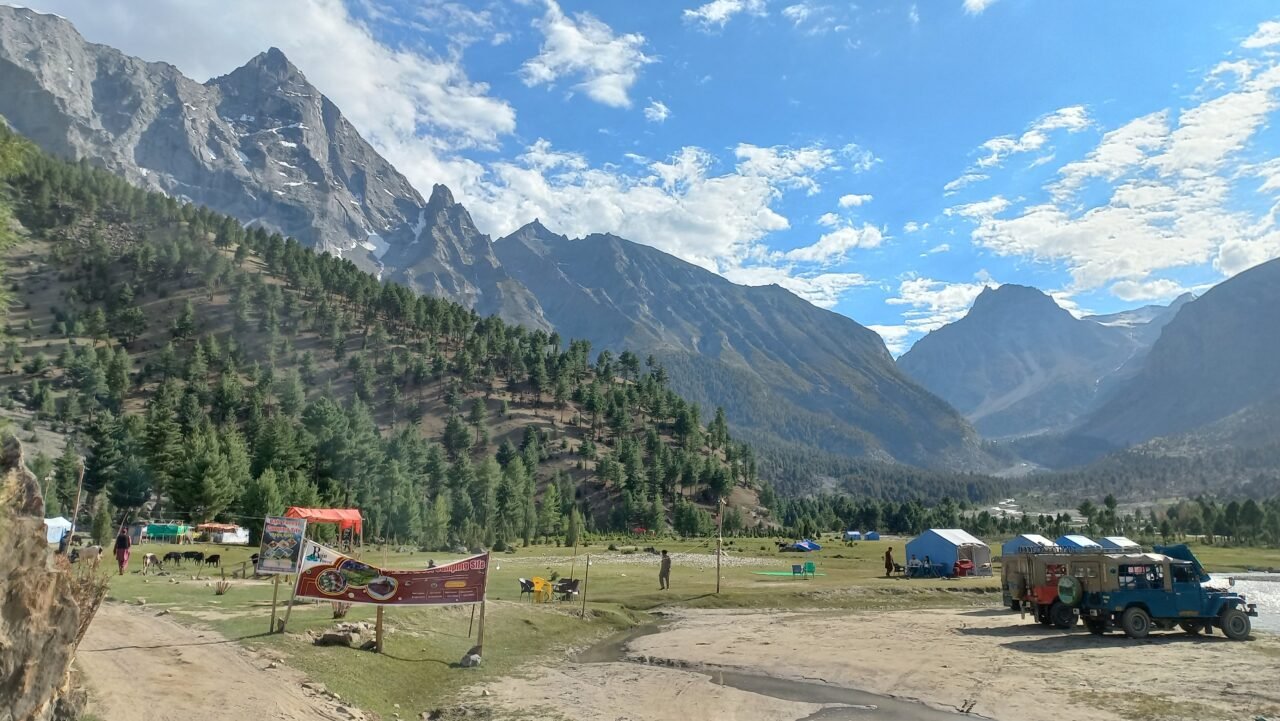
Basho Valley Skardu
In this comprehensive Basho Valley travel guide, we’ll guide you about the best time to visit Basho Valley, travel tips, Basho Valley’s top attractions, Basho Valley camping, how to plan your trip and everything you need to know for your next trip to Basho Valley.
Where is Basho Valley Located?
Basho Valley is situated in the Rondu District of Skardu Valley, Pakistan. When you start to travel on the Jaglot-Skardu Road (JSR) towards Skardu, after around 140 km, you will see the iconic hanging Basho Bridge on your right side; this is the bridge that will take you to Basho Valley.
Basho Valley Skardu has an elevation of around 10,000 ft above sea level in the Himalayan Mountain Range, and this elevation varies at different points in the valley. This valley is around 650 km from Islamabad, 140 km from Alam Bridge (Jaglot-Skardu Mor), 40 km from Skardu City, and 15 km from Kachura Town of Skardu.
Basho Valley Jeep Track:
Basho Jeep Track is around 10 km long, which starts from the Basho Bridge and takes around 1.5-2 hours. It is a steep, narrow, and quite bumpy jeep track. From the bridge to the valley, the elevation gain is around 3500 ft. Throughout this road, you pass through beautiful villages having lush green fields irrigated by the glacier water streams of Basho, a few old wooden bridges without the railings with gushing Basho Nala beneath, a few dhabas for chai pakora, and tuck shops selling juicy apricots, mulberries, jams, raisins, walnuts and other snacks.
You can hire these jeeps from Skardu City or the Basho Bridge. Only the local jeeps or bikes are allowed on this road. Traveling on Basho Road is not recommended in heavy rain or snow. For bikers, it is advised to carry mountain bikes and only one person must ride on it.
Basho Valley Bridge:
Basho Bridge is a hanging bridge, so it is always wobbly when you cross it. It is 450 ft long and can tolerate up to 1.5 tons of weight. One jeep can cross it at a time, and the other has to wait. It is built over the mighty Indus River gushing beneath you, giving you chills.
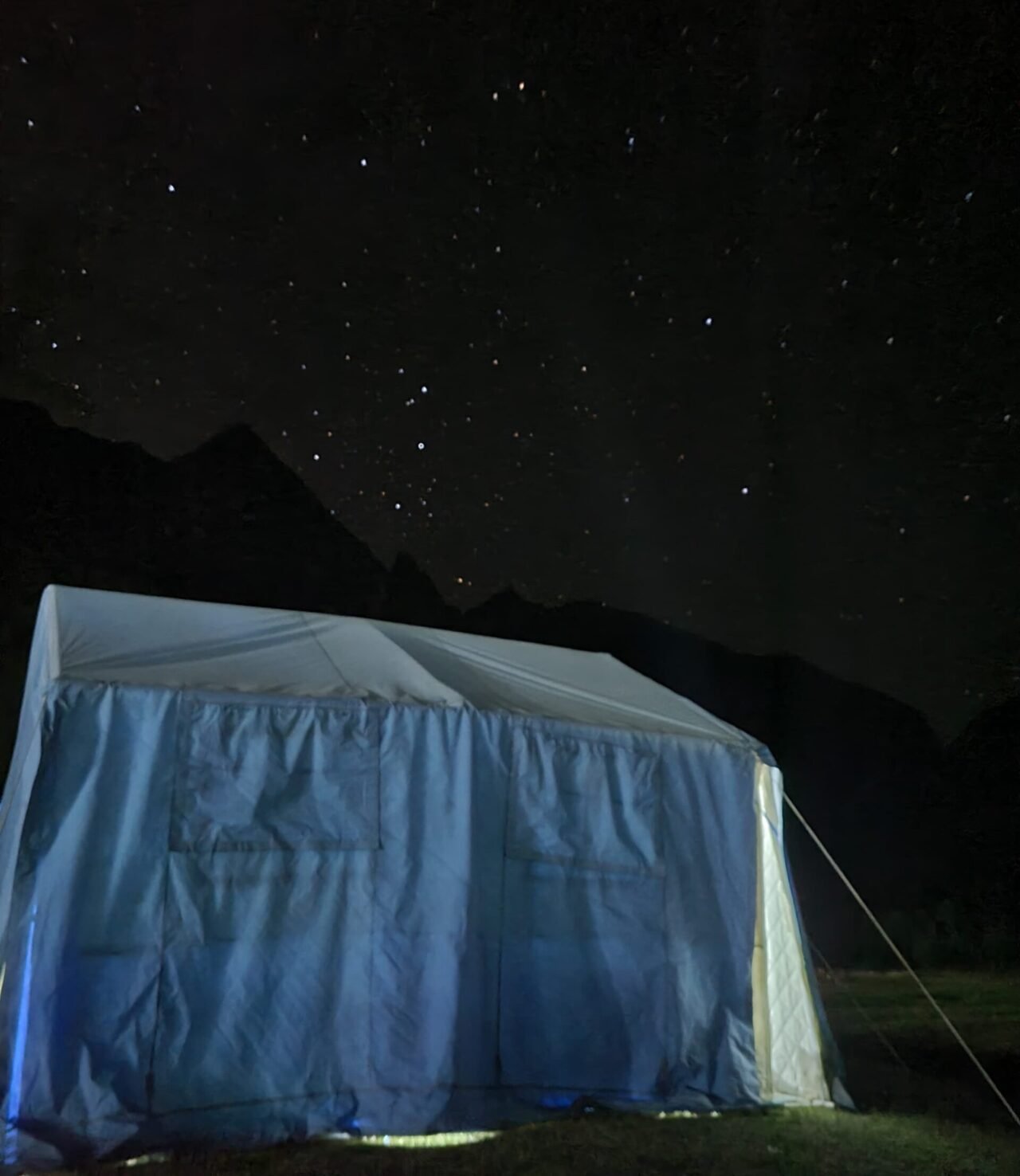
Night Sky from Basho Camping Site
Basho Valley Camping and Basho Valley Hotels:
There are several Basho Valley River Camping setups in Basho ranging from 1000 to 5000 PKR per night for each camp, depending upon the size and capacity of the camp. You can also set your camps here with a minimal rent. A few campsites have also set small one-room huts made of tin and wood for a bit of adventure luxury.
Suppose you plan to stay at Basho for the night, and you love outdoor adventures, gigantic mountains, starry night skies, water streams, grassy lands, woods, and the crisp air. In that case, Basho Valley Camping is the ultimate choice for you.
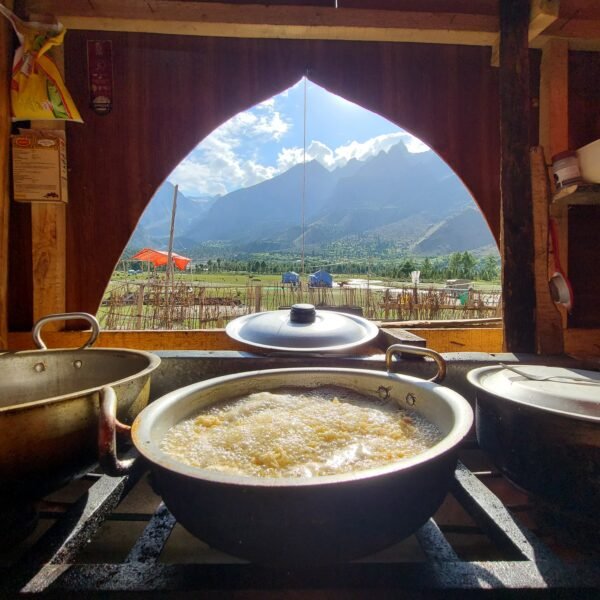
These camping sites have common toilets with only basic facilities. You can order local Balti or other Pakistani dishes from their kitchen camps, and you can also go for a BBQ and bonfire with precaution at the dedicated spaces inside the campsites.
Basho Valley Waterfalls:
When we cross the Basho Bridge, we witness a huge waterfall on the right edge of it known as the Basho Waterfall. This waterfall adds to the beauty of this valley. But, this is not a natural waterfall but an outflow from a hydropower plant installed in Basho to produce hydroelectric power. This power is used by the villages of this valley and some parts of Skardu. This water for the Basho Hydroelectric Power Project is collected from the streams of Basho Meadows. It later falls into the mighty Indus River forever.
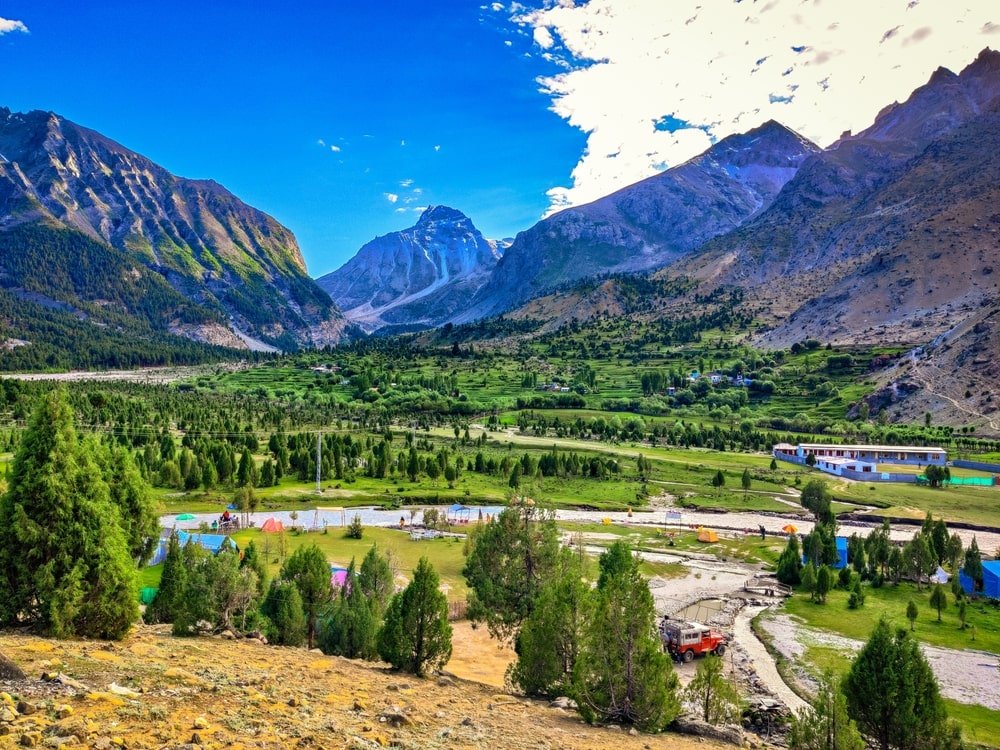
Basho Valley Pakistan
Best Time to Visit Basho Valley
This valley remains accessible almost all around the year for visitors. But the best time to visit Basho Valley is from May to October when the weather is pleasant for outdoor activities like hiking and camping. The valley becomes lush green in the summer months, from June to August. However the winter months, from November to March, the valley becomes a winter wonderland and is suitable for day trips only.
Basho Valley Places to Visit and Basho Valley Top Attractions:
- Camel Rock: If you want to do a basic 20-25-minute Basho Valley hiking, Camel Rock is the best choice for you. It is a rock formation that naturally resembles the back of a camel. Hence, the locals named it the Camel Rock Basho.
- Basho Valley Forest and Wildlife: Basho Forest is a small forest with the majority of Juniper trees and Pine Trees. This forest plays an important role in the wildlife of this region. The most prominent wildlife animals and birds in Basho are Marco Polo sheep, Ibex, Snow Leopards, Cows, Wild Horses, Mountain Sheep and Goats, and Snow Cock. Several community based projects are introduced to preserve the biodiversity of this valley with the corporation International Union for Conservation of Nature.
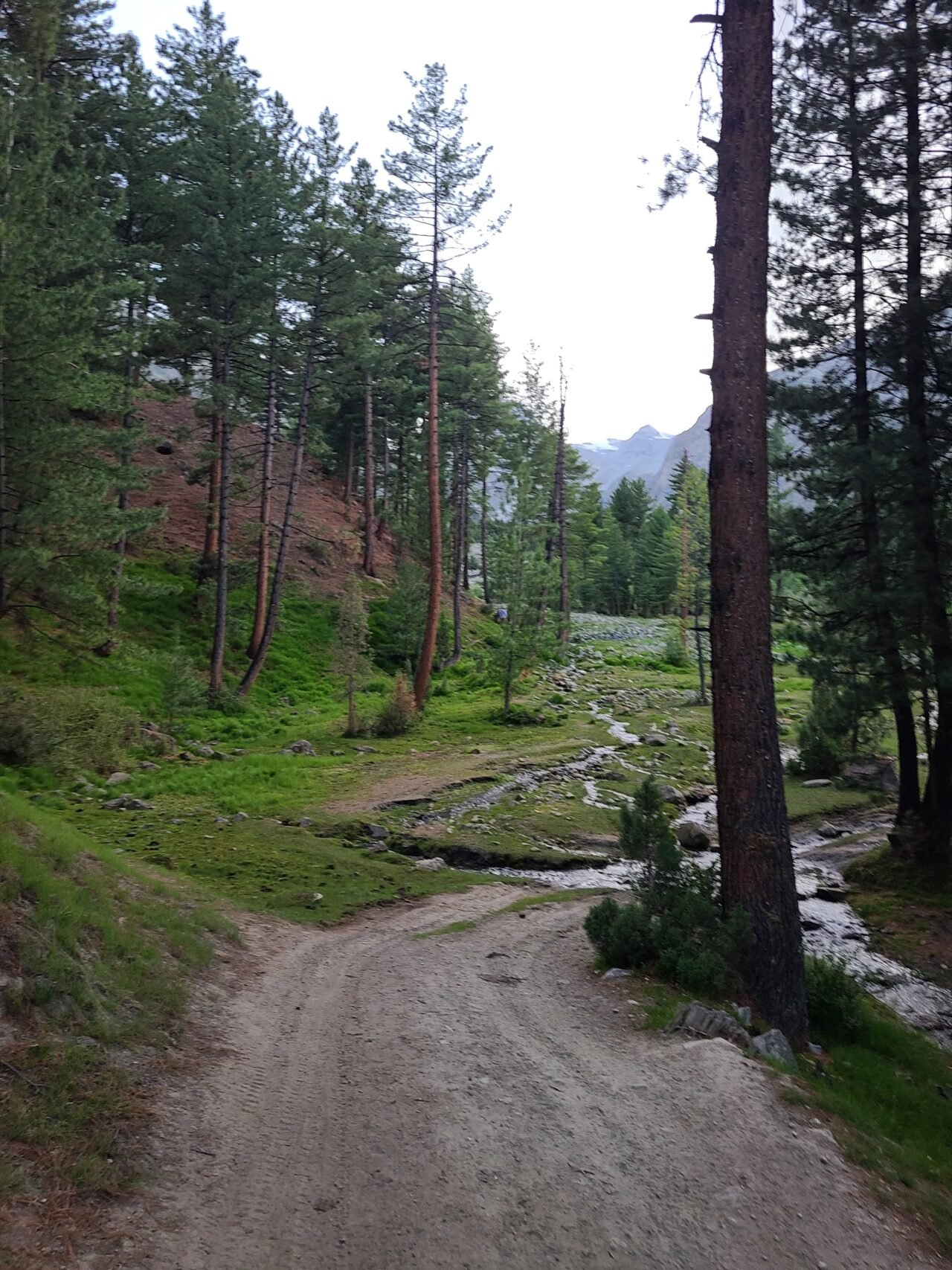
Basho Valley Pakistan
- Sultanabad Meadows Skardu and Village: Sultanabad Village is the home of the people of Basho Meadows. It is not open to tourists due to privacy issues. If visited with permission and respect, the village offers a glance into the Basho Valley’s local culture and a closer look into their living style.
- Basho Lakes: There are three small lakes surrounding Basho, which is a two-day trek from Basho Meadows. All three lakes are not too big and fed by the glacier water. These lakes are still unnamed, and if you plan to visit, it is recommended to take a local guide with you.
- Basho to Astore Valley Trek: This trek passes through Banak La Pass, which connects Basho with Shigar Thang and Astor Valley (Gutum Sar).
Surrounding Valleys:
- Bilamik Valley and Thorche (Thorsey) Valley
- Soq Valley
- Shigarthang
- Chunda Valley
- Deosai National Park
Are You Planning a Basho Valley Tour?
At NatureHikePakistan.pk, we are here to cater the best Basho Valley Skardu tour packages for families or avid travelers.
Contact us right now to get a free quote for your next Basho Valley Tour.
Basho Valley Skardu, locally known as Sultanabad Meadows Skardu, is situated in the picturesque and adventure lovers’ favorite Rondu District of Skardu Valley, Gilgit Baltistan. Basho is a word in the Balti Language that translates to Barberries or Dried Grapes (resins). The barberry bushes are abundant in this valley. Hence, it is named Basho Valley.
Basho Valley Skardu is famous for its jaw-dropping rocky mountain backdrop, glacier water streams, grassy lands and super adventurous jeep ride. Both families and intrepid travelers equally cherish it. If you are looking for a relaxing retreat or an action-packed trip, Basho has a thing for you.
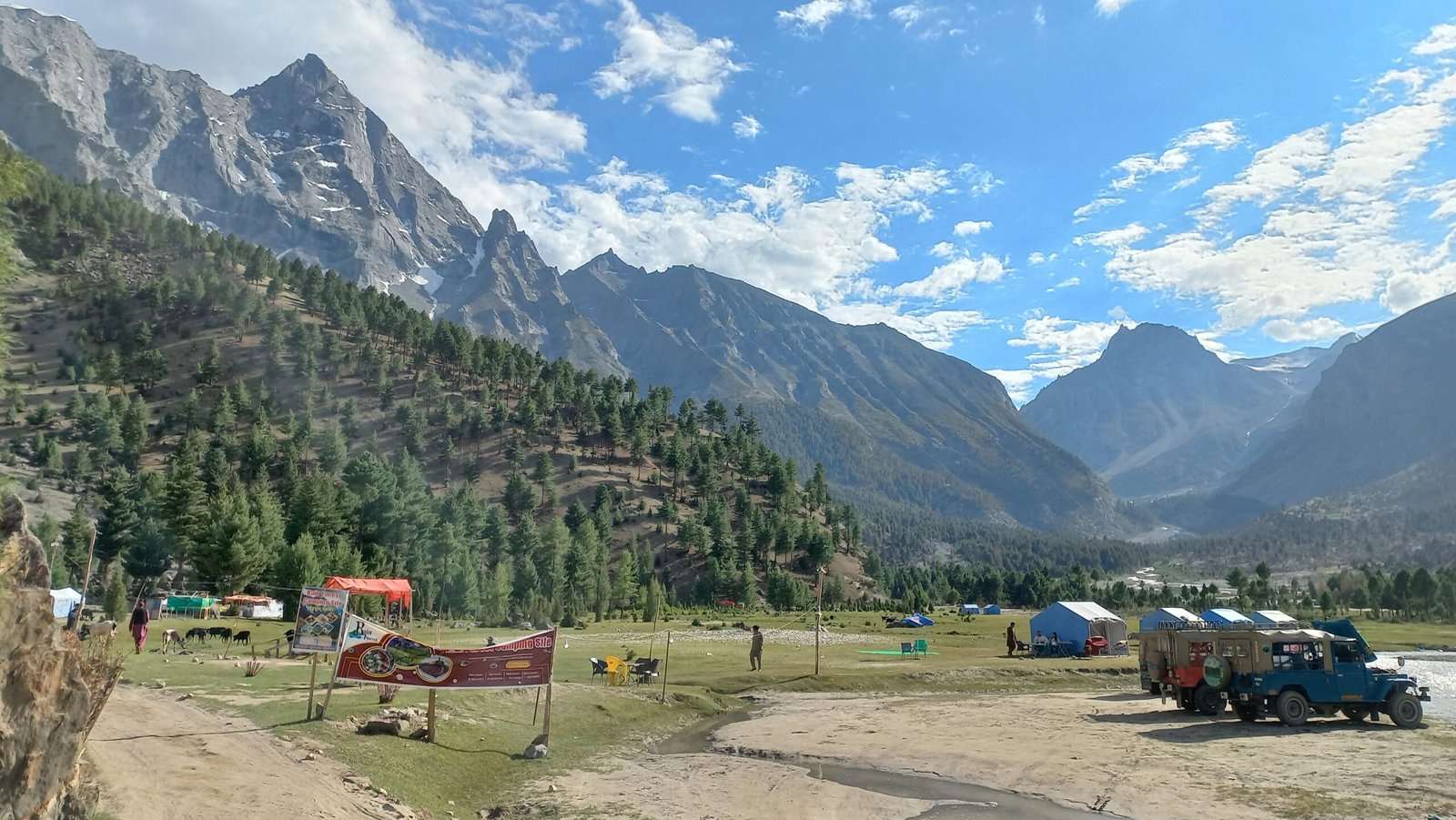
In this comprehensive Basho Valley travel guide, we’ll guide you about the best time to visit Basho Valley, travel tips, Basho Valley’s top attractions, Basho Valley camping, how to plan your trip and everything you need to know for your next trip to Basho Valley.
Where is Basho Valley Located?
Basho Valley is situated in the Rondu District of Skardu Valley, Pakistan. When you start to travel on the Jaglot-Skardu Road (JSR) towards Skardu, after around 140 km, you will see the iconic hanging Basho Bridge on your right side; this is the bridge that will take you to Basho Valley.
Basho Valley Skardu has an elevation of around 10,000 ft above sea level in the Himalayan Mountain Range, and this elevation varies at different points in the valley. This valley is around 650 km from Islamabad, 140 km from Alam Bridge (Jaglot-Skardu Mor), 40 km from Skardu City, and 15 km from Kachura Town of Skardu.
Basho Valley Jeep Track
Basho Jeep Track is around 10 km long, which starts from the Basho Bridge and takes around 1.5-2 hours. It is a steep, narrow, and quite bumpy jeep track. From the bridge to the valley, the elevation gain is around 3500 ft. Throughout this road, you pass through beautiful villages having lush green fields irrigated by the glacier water streams of Basho, a few old wooden bridges without the railings with gushing Basho Nala beneath, a few dhabas for chai pakora, and tuck shops selling juicy apricots, mulberries, jams, raisins, walnuts and other snacks.
You can hire these jeeps from Skardu City or the Basho Bridge. Only the local jeeps or bikes are allowed on this road. Traveling on Basho Road is not recommended in heavy rain or snow. For bikers, it is advised to carry mountain bikes and only one person must ride on it.
Basho Valley Bridge
Basho Bridge is an iconic suspension bridge that offers both thrill and breathtaking views for those brave enough to cross it.
As a hanging bridge, it naturally sways with every step you take, making the crossing an adrenaline-pumping experience. Stretching 450 feet in length, it’s designed to hold up to 1.5 tons of weight, which means it can safely accommodate a single jeep at a time—no exceptions. If you’re in a vehicle, expect to take turns, as the other vehicle will have to wait its turn to cross.
Suspended above the roaring Indus River, the bridge gives you a front-row seat to the river’s raw, untamed beauty. The sound of the rushing water below and the slight wobble of the bridge beneath your feet are enough to send chills down your spine—but it’s exactly what makes this crossing unforgettable.
Whether you’re an adventurer or just passing through, this bridge is a must-experience part of your journey.
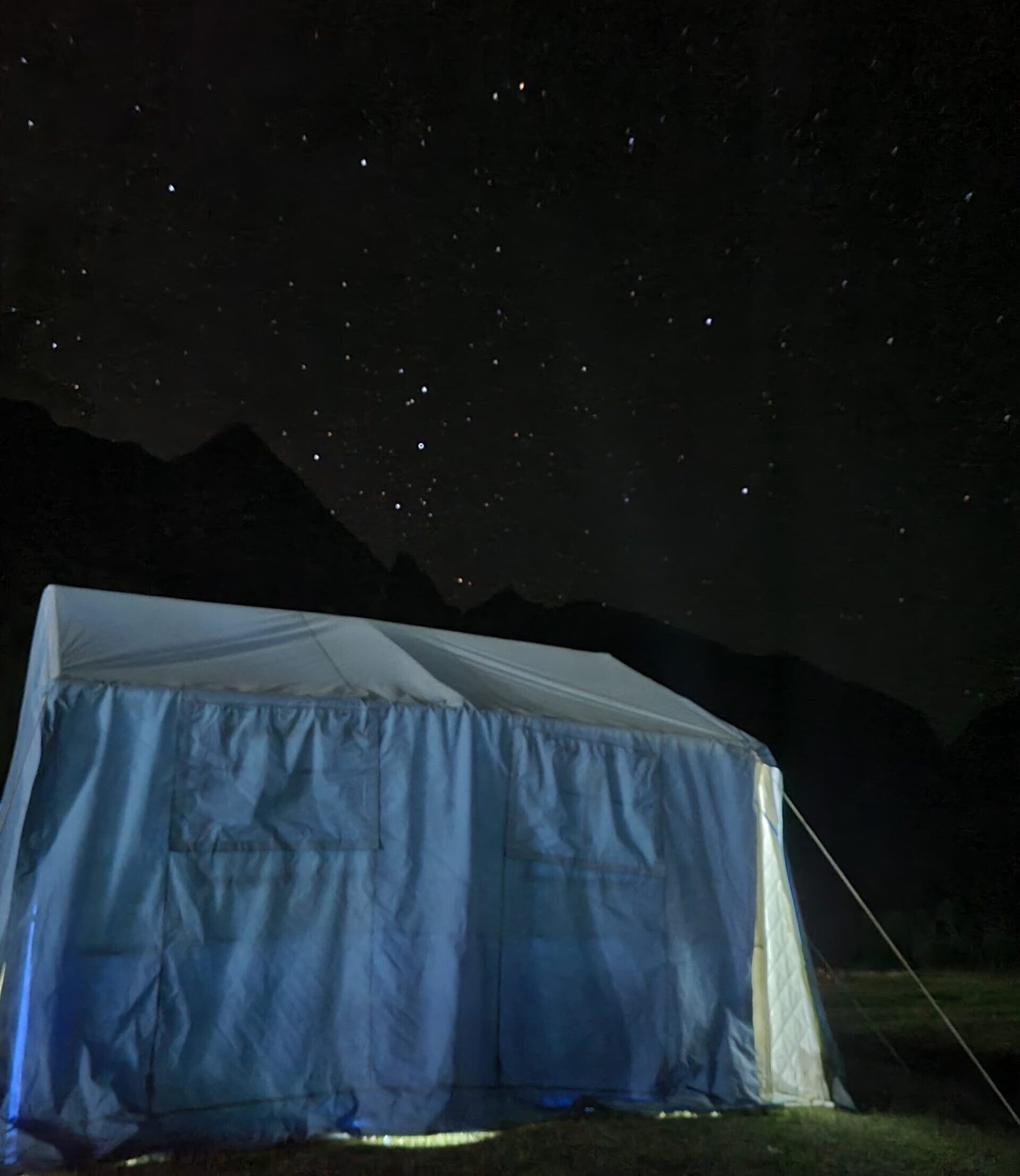
Basho Valley Camping and Basho Valley Hotels
There are several Basho Valley River Camping setups in Basho ranging from 1000 to 5000 PKR per night for each camp, depending upon the size and capacity of the camp.
You can also set your camps here with a minimal rent. A few campsites have also set small one-room huts made of tin and wood for a bit of adventure luxury.
Suppose you plan to stay at Basho for the night, and you love outdoor adventures, gigantic mountains, starry night skies, water streams, grassy lands, woods, and the crisp air. In that case, Basho Valley Camping is the ultimate choice for you.
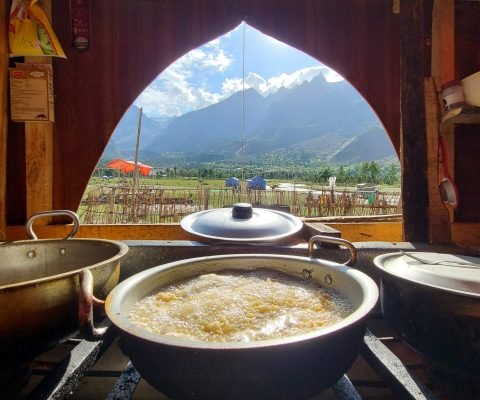
These camping sites have common toilets with only basic facilities. You can order local Balti or other Pakistani dishes from their kitchen camps, and you can also go for a BBQ and bonfire with precaution at the dedicated spaces inside the campsites.
Basho Valley Waterfalls
When we cross the Basho Bridge, we witness a huge waterfall on the right edge of it known as the Basho Waterfall. This waterfall adds to the beauty of this valley. But, this is not a natural waterfall but an outflow from a hydropower plant installed in Basho to produce hydroelectric power. This power is used by the villages of this valley and some parts of Skardu. This water for the Basho Hydroelectric Power Project is collected from the streams of Basho Meadows. It later falls into the mighty Indus River forever.
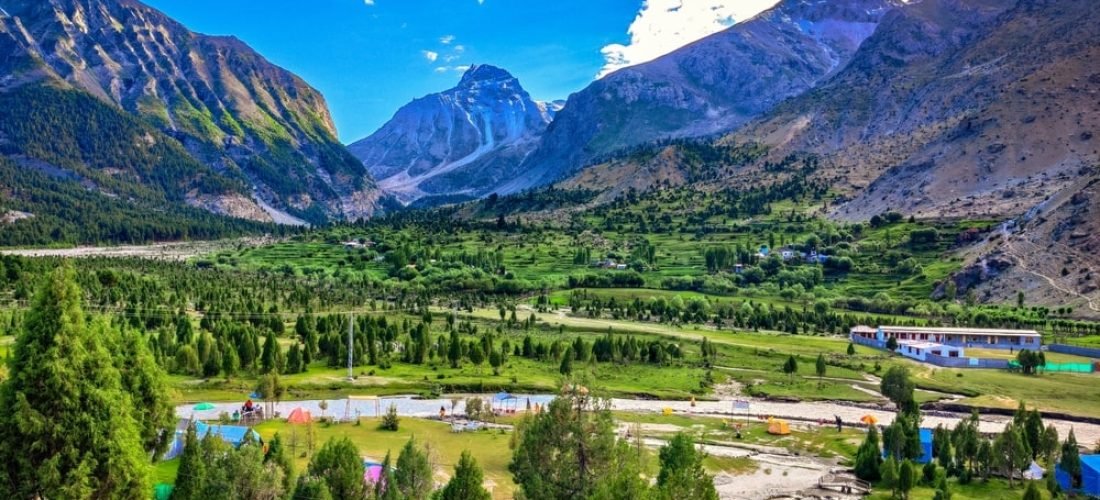
Best Time to Visit Basho Valley
This valley remains accessible almost all around the year for visitors. But the best time to visit Basho Valley is from May to October when the weather is pleasant for outdoor activities like hiking and camping. The valley becomes lush green in the summer months, from June to August. However the winter months, from November to March, the valley becomes a winter wonderland and is suitable for day trips only.
Basho Valley Places to Visit and Basho Valley Top Attractions
- Camel Rock: If you want to do a basic 20-25-minute Basho Valley hiking, Camel Rock is the best choice for you. It is a rock formation that naturally resembles the back of a camel. Hence, the locals named it the Camel Rock Basho.
- Basho Valley Forest and Wildlife: Basho Forest is a small forest with the majority of Juniper trees and Pine Trees. This forest plays an important role in the wildlife of this region. The most prominent wildlife animals and birds in Basho are Marco Polo sheep, Ibex, Snow Leopards, Cows, Wild Horses, Mountain Sheep and Goats, and Snow Cock. Several community based projects are introduced to preserve the biodiversity of this valley with the corporation International Union for Conservation of Nature.
- Sultanabad Meadows Skardu and Village: Sultanabad Village is the home of the people of Basho Meadows. It is not open to tourists due to privacy issues. If visited with permission and respect, the village offers a glance into the Basho Valley’s local culture and a closer look into their living style.
- Basho Lakes: There are three small lakes surrounding Basho, which is a two-day trek from Basho Meadows. All three lakes are not too big and fed by the glacier water. These lakes are still unnamed, and if you plan to visit, it is recommended to take a local guide with you.
- Basho to Astore Valley Trek: This trek passes through Banak La Pass, which connects Basho with Shigar Thang and Astor Valley (Gutum Sar).

Surrounding Valleys
FAQ's
You can hire a jeep from Skardu City or Basho Bridge.
No, only local jeeps are allowed on the Basho Jeep track.
There are several campsites at Basho, or you can also set up your camps with minimal rent.
